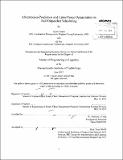Absenteeism prediction and labor force optimization in rail dispatcher scheduling
Author(s)
Jensen, Taylor (Taylor Moroni); Sun, Qi
DownloadFull printable version (10.55Mb)
Other Contributors
Massachusetts Institute of Technology. Engineering Systems Division.
Advisor
Anthony J. Craig.
Terms of use
Metadata
Show full item recordAbstract
Unplanned employee absences are estimated to account for a loss of 3% of scheduled labor hours. This can be costly in railroad dispatcher scheduling because every absence must be filled through overtime or a qualified extra dispatcher. One factor that complicates this problem is the uncertainty of unplanned employee absences. The ability to predict unplanned absences would facilitate effective scheduling of extra dispatchers and help reduce overtime costs. This thesis uses data from a railroad company over a four year period to examine company-wide factors thought to impact the number of unplanned absences among dispatchers. Using Poisson regression, we identify several factors that provide statistical evidence of influencing the number of unplanned absences. These factors are month, snowstorms, shift, and certain holidays. Despite these findings, the overall predictive capability of our regression model is very weak. Instead, we model the number of unplanned absences by shift as a Hadrom process with a Negative Binomial distribution and use Monte Carlo simulation to explore the impact on overtime costs of increasing the number of scheduled extra dispatchers and increasing the number of positions on which each employee is qualified to work. Our results show that increasing the number of extra dispatchers has a greater effect on reducing overtime, but the cost savings from reducing overtime expenses are not enough to offset the additional labor costs of having more employees on staff. Our results provide insight regarding the relationship among extra staff, higher levels of qualification among employees, and the willingness to use overtime in handling unplanned absences.
Description
Thesis: M. Eng. in Logistics, Massachusetts Institute of Technology, Engineering Systems Division, 2013. Cataloged from PDF version of thesis. Includes bibliographical references (pages 61-62).
Date issued
2013Department
Massachusetts Institute of Technology. Engineering Systems DivisionPublisher
Massachusetts Institute of Technology
Keywords
Engineering Systems Division.